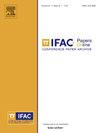Modeling human-autonomy team steering behavior in shared-autonomy driving scenarios
Q3 Engineering
引用次数: 0
Abstract
Well-accepted models such as the two-point steering model and its variations describe human steering behavior in non-autonomous vehicles. However, these models may not describe human steering in a shared autonomous vehicle, where the human driver cooperates with an autonomous controller. This work explores how the generalized two-point steering model, a variation of the classical two-point model, may apply to human steering in a shared autonomous vehicle. This study reports two key findings: (1) We find that humans do not necessarily steer the vehicle to the exact lane center, perhaps due to imprecise distance perception or a preference to stay off-center in the lane. Thus, we propose adding a steering bias term to the generalized steering model to account for this behavior; (2) We also find that human steering adapts so that the overall team steering–the combined human and autonomous steering input–behaves according to the generalized steering model with this new bias term. We collected data over 150 runs across 5 drivers and 3 levels of autonomy, and found that the modified generalized steering model accurately predicts team steering behavior.
共享自动驾驶场景下人类自主驾驶团队转向行为建模
一些广为接受的模型,如两点转向模型及其变体,描述了人类在非自动驾驶汽车中的转向行为。然而,这些模型可能无法描述共享自动驾驶汽车中的人类驾驶,在共享自动驾驶汽车中,人类驾驶员与自动控制器合作。这项工作探讨了广义两点转向模型(经典两点模型的一种变体)如何应用于共享自动驾驶汽车中的人类转向。本研究报告了两个关键发现:(1)我们发现人类不一定会将车辆驾驶到准确的车道中心,这可能是由于不精确的距离感知或偏好在车道上保持偏离中心。因此,我们建议在广义转向模型中加入转向偏差项来解释这种行为;(2)我们还发现,人的转向具有适应性,使得整个车队的转向——人的转向和自动转向相结合的输入——符合具有新偏差项的广义转向模型。我们收集了超过150次的数据,跨越5个驾驶员和3个自治级别,发现改进的广义转向模型可以准确预测团队转向行为。
本文章由计算机程序翻译,如有差异,请以英文原文为准。
求助全文
约1分钟内获得全文
求助全文
来源期刊

IFAC-PapersOnLine
Engineering-Control and Systems Engineering
CiteScore
1.70
自引率
0.00%
发文量
1122
期刊介绍:
All papers from IFAC meetings are published, in partnership with Elsevier, the IFAC Publisher, in theIFAC-PapersOnLine proceedings series hosted at the ScienceDirect web service. This series includes papers previously published in the IFAC website.The main features of the IFAC-PapersOnLine series are: -Online archive including papers from IFAC Symposia, Congresses, Conferences, and most Workshops. -All papers accepted at the meeting are published in PDF format - searchable and citable. -All papers published on the web site can be cited using the IFAC PapersOnLine ISSN and the individual paper DOI (Digital Object Identifier). The site is Open Access in nature - no charge is made to individuals for reading or downloading. Copyright of all papers belongs to IFAC and must be referenced if derivative journal papers are produced from the conference papers. All papers published in IFAC-PapersOnLine have undergone a peer review selection process according to the IFAC rules.
 求助内容:
求助内容: 应助结果提醒方式:
应助结果提醒方式:


